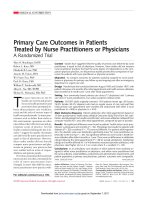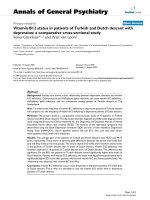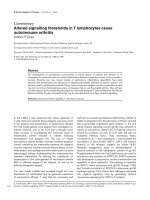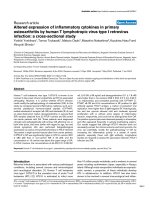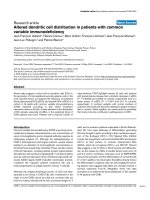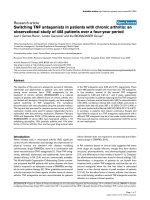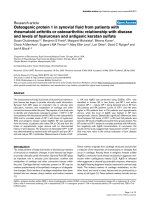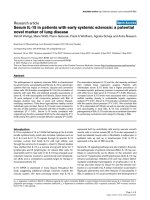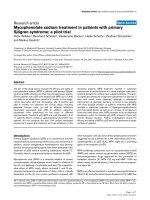Báo cáo y học: "Altered postural sway in patients suffering from non-specific neck pain and whiplash associated disorder - A systematic review of the literature." pps
Bạn đang xem bản rút gọn của tài liệu. Xem và tải ngay bản đầy đủ của tài liệu tại đây (295.06 KB, 11 trang )
REVIEW Open Access
Altered postural sway in patients suffering from
non-specific neck pain and whiplash associated
disorder - A systematic review of the literature
Alexander Ruhe
1*
, René Fejer
2
and Bruce Walker
3
Abstract
Study design: Systematic literature review.
Objectives: To assess differences in center of pressure (COP) measures in patients suffering from non-specific neck
pain (NSNP) or whiplash-associated disorder (WAD) compared to healthy controls and any relationship between
changes in postural sway and the presence of pain, its intensity, previous pain duration and the perceived level of
disability.
Summary of Background data: Over the past 20 years, the center of pressure (COP) has been commonly used as
an index of postural stability in standing. While several studies investigated COP excursions in neck pain and WAD
patients and compared these to healthy individuals, no comprehensive analysis of the reported differences in
postural sway pattern exists.
Search methods: Six online databases were systematically searched followed by a manual search of the retrieved
papers.
Selection Criteria: Papers comparing COP measures derived from bipedal static task conditions on a force plate of
people with NSNP and WAD to those of healthy controls.
Data collection and analysis: Two reviewers independently screened titles and abstracts for relevance. Screening
for final inclusion, data extraction and quality assessment were carried out with a third reviewer to reconcile
differences.
Results: Ten papers met the inclusion criteria. Heterogeneity in study designs prevented pooling of the data and
no direct comparison of data across the studies was possible. Instead, a qualitative data analysis was conducted.
There was broad consensus that patients with either type of neck pain have increased COP excursions compared
to healthy individuals, a difference that was more pronounced in people with WAD. An increased sway in antero-
posterior direction was observed in both groups.
Conclusions: Patients with neck pain (due to either NSNP or WAD) exhibit greater postural instability than healthy
controls, signified by greater COP excursions irrespective of the COP parameter chosen. Further, the decreased
postural stability in people with neck pain appears to be associated with the presence of pain and correlates with
the extent of proprioceptive impairment, but appears unrelated to pain duration.
Keywords: Balance, center of pressure, force-plate, neck pain, whiplash, systematic review
* Correspondence:
1
Murdoch University. Praxis fuer Chiropraktik Wolfsburg, Porschestrasse 1,
38440 Wolfsburg, Germany
Full list of author information is available at the end of the article
Ruhe et al. Chiropractic & Manual Therapies 2011, 19:13
/>CHIROPRACTIC & MANUAL THERAPIES
© 2011 Ruhe et al; licensee BioMed Central Ltd. This is an Open Access article distributed under the terms of the Creative Commons
Attribution License ( which permits unrestricted use, distribution, and reproduct ion in
any medium, provided the original work is properly cited.
Background
Rationale
Ideally, the body should be able to generate quick center
of pressure (COP) transitions that just exceed the current
position of the center of mass (COM) [1] and accelerate it
into the opposite direction in o rder to maintain balance.
Any condition effecting the afferent sensory pathways may
interfere with this process. The neck is particularly prone
to this due to the abund ant cervical sensory receptors in
joints and muscles [2,3] as well as their central and reflex
connections to visual, vestibular and postural control
systems [4].
The debate continues however, as to whether the
cause of abnormal cervical afferent input is primarily
proprioceptive or nocioceptive in nature. Deterioration
of this proprioceptive information from the neck may be
the determining factor in reducing the accuracy in the
sensory integration process. The resulting imprecise
estimation of the COM position may then lead to an
incr ease in the safety margin of the adaptive COP shifts
with regard to the predicted COM oscillations [5].
The excitation of chemosensitive nociceptors in cervical
facet joints and muscles may alter the sensitivity of the
muscle spindles by reflex activation of fusimotor neurones
[6], leading to a decreased proprioceptive acuity. This
effect may be triggered by marked activation of mechano-
sensitive nociceptors as occurs in whiplash injuries [7].
Acute “pain inhibition” [8] may be another mechanism
where discharge from high-threshold nociceptive afferents
interferes with spinal motor-pathways as well as the motor
cortex. Pain may also cause an increased pre-synaptic inhi-
bition of muscle afferents [9] as well as affect the central
modulation of prop rioceptive spindles o f muscles [10 ],
causing prolonged latencies. Such alterations may lead to
decreased muscle control and result in increased postural
sway.
In the case of whiplash associated disorder (WAD), facet
joint components may be at risk of injury due to compres-
sion during rear-impact accelerations while capsular liga-
ments are at risk of injury at higher accelerations [11].
Depending on the magnitudeoftrauma,theresulting
impairment of the sensory system is therefore likely to be
more pronounced compared to cases of non-specific neck
pain (NSNP).
Several attempts have been made to investigate differ-
ences in COP sway pattern between people with NSNP
and heal thy controls by means of forceplate tilting [12],
body leaning [13] or vibratory stimulation to structures
of the neck [14]. Although these approaches contribute
important knowledge to the field, an experimental setup
without additional equipment for stimulation or external
perturbation that can be applied comprehensively for a
broad spectrum of complaints may be of additional use.
We previously described that such a simple static setup
is not only highly discriminative for non-specific low
back pain [15] but also allowed the observation of a lin-
ear relationship between the perceived pain intensity
and COP sway velocity [16]. If people with NSNP can
also be identified by COP measurements during such
basic postural tasks, similar relationships are likely and
may allow for comparison of postural sway between
painful regions.
This literature review will attempt to identify possible
differences in COP pattern between people with WAD,
people with NSNP and healthy controls that may relate to
the mechanisms described above. As COP measures are
commonly used in a clinical setting, this will allow the
researcher or clinician to put their results into context. To
our knowledge no comprehensive systematic review has
been conducted to investigate the possible impact of neck
pain on COP pattern during bipedal static tasks and the
possible association of this effect with pain intensity or
disability.
Objective
The objective of this systemat ic literature review is to 1)
determine if there are significant differences in postural
sway between peop le with NSNP and WAD patients and
healthy controls, 2) investigate whether the magnitude of
these COP excursions are related to the level of pain per-
ception, previous pain duration or perceived level of
disability.
Methods
Search
A comprehensive search strategy was developed by iden-
tifying all potentially relevant search terms, categorizing
these terms into specific search phas es and subsequently
combining them by using Boolean terms. This search
strategy was appli ed t o six diffe rent electronic databases:
PubMed, MEDLINE, EMBASE , Web of Science, Science-
Direct and the Cochrane library. The date range of publi-
cations searched was from January 1980 to January 2011.
The follow ing key words were used in the search strat-
egy: “neck pain”, “cervical pain”, “whiplash”, “WAD”, “cen-
ter of pressure”, “ COP”, “ balance” , “posture”, “ postural
stability”, postural control”. The detailed search strategy is
available upon contacting the corresponding author.
The hand search included analyzing references cited in
studies selected from the original online search. Citation
searches of relevant studies were conducted using the
PubMed, MEDLINE and ScienceDirect databases.
Eligibility criteria
Papers were limited to th ose published in peer-reviewed
journals without language restrictions.
Ruhe et al. Chiropractic & Manual Therapies 2011, 19:13
/>Page 2 of 11
The inclusion criteria were: the study investigated
force changes over time (postural sway) exhibited by
participants with NSNP or WAD derived from bipedal
static task conditions on a forceplate, ideally compared
to measures of healthy controls. For the purpose of this
review, NSNP was broadly defined as pain in the cervi-
cal area of musculoskeletal origin in the absence of any
neurological symptomatology or serious pathology such
as cancer or infection. Induced neck pain in otherwise
healthy participants is considered as non-specific neck
pain.
The selection criteria for this review does not concern
study type as the focus is comparing COP sway data irre-
spective of the original research purpose of the study.
Further, the quality of the various postural sway mea-
sures depends on technical aspects of the experimental
setup. Therefore all study designs were considered.
We excluded studies with insufficient documentation of
patient demographics or experimental setup where this
rendered data extraction impossible. In addition, papers
that were anecdotal, speculative or editorial in nature or
studies that employed dynamic task conditions such as
one-leg hopping, walking or some form of translation of
the force platform were excluded.
Information sources
Study selection
For the purpose of this review AR acted as the principal
reviewer. A colleague (TB) was involved independently
in the process of identifying relevant studies but did not
participate in further analysis of the finally included
papers. Where discrepancies between AR and TB were
not reconciled by discussion, a third rev iewer was used
for a majority decision.
Data collection process
To standardize the procedure between the reviewers, the
main author developed a detailed data extraction sheet to
acquire general information on objectives , design, partici-
pant’ s demographics and outcomes. If any title and
abstract did not provide enough information to decide
whether or not the inclusion criteria were met, the article
was included for the full text selection.
With regard to the research question, data extraction
was concerned with four main areas regarding the associa-
tion between neck pain and postural sway: 1) perceived
pain intensity, 2) previous pain duration, 3) reported dis-
ability levels and 4) the experimental setup applied.
For the latter, we extracted data on 1) sampling dura-
tion, 2) number of trials, 3) sampling and cut-off fre-
que ncy, 4) foot position, 5) visual condition (eyes open/
closed), 6) surface condition (firm/compliant) as well as
7) the COP parameters used. These points were based
on recommendations for obtaining reliable COP
measures [17].
Summary measures
The principle summary measure in the included studies
was differences in means.
Synthesis of results
We planned to combine the results of the included studies
to conduct inter-study comparisons of means and statisti-
cal differences. We also planned to do this for NSNP and
WAD separately and combined to investigate differences
between the two.
Results
Study selection
Initially, the database search strategy identified 203 studies
of which titles and abstracts were screened individually by
the reviewers. The application of inclusion/exclusion
criteria and consensus by the reviewers on the t itles and
abstracts eliminated 182 papers. From the titles and
abstracts of papers selected (n = 23), full papers were
reviewed by the same two reviewers (AR and TB) who
applie d the inclusion criteria to the full text. Of these, 10
studies met the inclusion criteria and were included in this
review (Figure 1). There was full consensus between the
reviewers during the selection process of included papers.
Study characteristics
Combining results was not possible due to the heteroge-
neous study designs and patient characteristics across
the included studies. There fore only a general trend is
noted.
Both subject demographics and health status for all
studies are shown i n Table 1. The number of sympto-
matic participants and the matching number of controls
was generally small and ranged between seven [18] and
fifty [19]. All but two of the included studies (8/10,
Number of additional records identified
through other sources: n=4
Number of abstracts after duplicates
removed: n=204
Number of abstracts
screened: n=182
Number of records identified through database
searching: n=203
Number of abstracts excluded:
n=161
Full text articles assessed for
eligibility: n=23
Full text articles excluded: n=13
Reason:
Study design (n=9)
Insufficient documentation (n=3)
Duplicate publication (n=1)
Full text articles included:
n=10
Figure 1 Flowchart of considered studies.
Ruhe et al. Chiropractic & Manual Therapies 2011, 19:13
/>Page 3 of 11
80%) enrolled mixed gender groups of healthy and
symptomatic participants. The studies employed differ-
ent age ranges of part icipants, with 20-40 years being
most commonly enrolled (7/10, 70%).
General shortfalls in the documentation of technical
aspects of COP acquirement were apparent. In additi on,
few authors described the baseline demographics of the
participants in appropriate detail, including weight,
height, age and gender (3/10, 30%).
There was a marked variation present in the included
studies in terms of sampling duration, number of trials or
the selection of the COP parameters. The studies often
employed a combination of different positional and visual
setups in order to investigate postural sway in various chal-
lenging positions. The resulting variation in results can be
observed irrespective of the COP parameter chosen.
Table 2 shows the study characteristics for sway assess-
ment in people with NSNP. The majority of trials were
performed under both eyes o pen (EO) and eyes closed
(EC) condition (4/6, 67%) with only a single repetition (5/
6, 83%). Sway area and root mean square (RMS) amplitude
were the most commonly used COP parameters.
The study characteristics for trials enrolling WAD
patients are presented in Table 3. Only a single record-
ing was used in most cases (6/7, 86%), but in contrast to
the NSNP studies, all study designs employed both
visual conditions.
Reliability of COP data
Table 4 gives an overview of how the studies included
meet the ideal experimental setup for reliable data.
With the ex cepti on of one paper t hat only measured
postural sway under visual deprivation [20], all of the
studies included assessed COP with both eyes open and
eyes closed. No study applied best practice experimental
setup throughout.
Pain assessment
All symptomatic participants experienced pain at the
time of recording. About 75% of studies described the
total neck pain duration prior to the COP measure-
ments whereby the pain history ranged from acute,
induced pain to 97 (SD 68) months. Of these studies,
half (5/8, 63%) assessed both the duration and the per-
ceived pain intensity by using either the visual analogue
scale (VAS) [19-22 ] or the 11-box numeric rating scale
(NRS-11) [23].
The perceived pain lev els varied between the studies
(Table 5). The pain intensity of WAD patients ranged
between VAS 2.2 (SD 0.9) [22] and 4.9 (SD 2.3) [21],
Table 1 Participant demographics and health status
Study Participant status Gender (n) Female
Male
Age in years Mean (SD) Weight in kg Mean (SD) Height in cm Mean (SD)
McPartland et al. [18] NSNP * 6 1 39.1 - -
healthy * 4 3 39.4 - -
Michaelson et al. [21] chronic NSNP 9 0 40 (9) 73 (18) 165 (7)
chronic WAD 6 3 44 (10) 79 (14) 171 (10)
healthy 13 3 41 (9) 70 (14) 168 (8)
Madeleine et al. [23] chronic WAD * 7 4 33.3 (6.7) 73.4 (11.4) 173.3 (7.2)
healthy/induced NP 7 4 33.1 (6.8) 68.0 (12.5) 171.5 (6.3)
Treleaven et al. [19] WAD (dizziness) 38 12 35.6 - -
WAD (no dizziness) 38 12 35.8 - -
healthy 28 22 29.9 - -
Storaci et al. [26] WAD 24 16 28.4 (8.8) - -
healthy 23 17 33.9 (12.7) - -
Endo et al. [25] WAD 19 13 39.0 (10.1) - -
healthy 4 16 37.9 (9.3) - -
Treleaven et al. [27] WAD 15 5 46.5 - -
healthy 14 6 49.5 - -
Field et al. [22] WAD 24 6 30.3 (1.3) - -
NSNP 23 7 27.9 (1.3) - -
healthy 23 7 26.8 (1.3) - -
Poole et al. [24] NSNP 20 0 65-82 - -
healthy 20 0 65-82 - -
Vuillerme et al. [20] healthy/induced NP 0 16 22.2 (1.8) 73.0 (11.8) 181.4 (6.4)
NP: neck pain, NSNP: non-specific neck pain, SD: standard deviation, WAD: whiplash-associated disorder.
* one patient and one control participants did not participate in COP measurement.
- : not described.
Ruhe et al. Chiropractic & Manual Therapies 2011, 19:13
/>Page 4 of 11
Table 2 Study characteristics and selected COP parameters measured in people with NSNP
Study Condition Duration
(sec)
Number of
trials
Parameter Neck pain
Result (SD)
Healthy controls
Result (SD)
p value
McPartland et al.
[18]
normal stance
EO/EC/F
30 6 absolute EO/F: 4.2 EO/F: 3.3 p < 0.05
sway Vel † EC/F: 4.3 EC/F: 3.4 ns
narrow stance
EO/EC/F
30 6 absolute EO/F: 4.4 EO/F: 3.7 ns
sway Vel † EC/F: 5.3 EC/F: 4.4 ns
Michaelson et al.
[21]
narrow stance,
EO/EC/F
20 1 sway area (mm
2
) EO: 105 (73) EO: 66 (47) -
EC: 166 (117) EC: 109 (65) -
Madeleine et al.
[23]∞
narrow stance,
EO/F
45 1 displacement ampl.
AP (mm)
EO: ~2.7 * EO: ~2.1 -
displacement ampl.
ML (mm)
EO: ~1.7 * EO: ~1.0 -
Field et al. [22]∞ normal stance
EO/EC/F/C
30 1 AP RMS amplitude
(mm)
EO/F: ~1.3 EO/F: ~1.2 ns
EC/F: ~1.4 EC/F: ~1.1 p < 0.05
EO/C: ~2.2 EO/C: ~2.3 ns
EC/C: ~2.5 EC/C: ~2.4 ns
ML RMS amplitude
(mm)
EO/F: ~2.6 EO/F: ~2.4 ns
EC/F: ~3.4 EC/F: ~2.8 ns
EO/C: ~4.1 EO/C: ~4.1 ns
EC/C: ~6.2 EC/C: ~5.6 ns
narrow stance,
EO/EC/F/C
30 1 AP RMS amplitude
(mm)
EO/F: ~3.3 EO/F: ~3.1 ns
EC/F: ~4.5 EC/F: ~4.0 ns
EO/C: ~4.5 EO/C: ~4.4 ns
EC/C: ~7.6 EC/C: ~6.9 ns
ML RMS amplitude
(mm)
EO/F: ~5.2 EO/F: ~5.1 ns
EC/F: ~6.5 EC/F: ~5.6 p < 0.05
EO/C: ~6.1 EO/C: ~6.0 ns
EC/C: ~9.0 EC/C: ~8.2 ns
Poole et al. [24]
∞
normal stance,
EC/EO/F/C
30 1 AP RMS amplitude
(mm)
EO/F: ~2.3 EO/F: ~3.1 ns
EC/F: ~5.0 EC/F: ~3.0 p = 0.02
EO/C: ~5.8 EO/C: ~4.2 p = 0.01
EC/C: ~7.5 EC/C: ~6.2 ns
30 1 ML RMS amplitude
(mm)
EO/F: ~1.7 EO/F: ~1.8 ns
EC/F: ~1.9 EC/F: ~1.6 ns
EO/C: ~3.8 EO/C: ~2.8 ns
EC/C: ~3.8 EC/C: ~3.5 ns
narrow stance,
EC/EO/F/C
30 1 AP RMS amplitude
(mm)
EO/F: ~4.2 EO/F: ~3.6 ns
EC/F: ~4.4 EC/F: ~4.2 ns
EO/C: ~5.9 EO/C: ~5.1 p = 0.01
EC/C: ~8.2 EC/C: ~8.3 ns
30 1 ML RMS amplitude
(mm)
EO/F: ~6.6 EO/F: ~5.0 p = 0.02
EC/F: ~7.3 EC/F: ~6.0 ns
EO/C: ~8.3 EO/C: ~7.5 ns
EC/C: ~10.6 EC/C: ~10.7 ns
Vuillerme et al.
[20] ∞
normal stance,
EC/F
10 1 Variance (mm
2
) ~19.5 * ~13.5 p < 0.05
Ruhe et al. Chiropractic & Manual Therapies 2011, 19:13
/>Page 5 of 11
Table 2 Study characteristics and selected COP parameters measured in people with NSNP (Continued)
range (mm) ~ 20.3* ~15.5 p < 0.01
mVel (mm/s) ~17.0 * ~11.3 p < 0.001
∞ The results presented have been extracted from bar-charts.
* Induced neck pain cases and healthy participants are identical.
- : not described
†: unit not described
AP: antero-posterior, BP: bipedal, displ. ampl: displacement amplitude, C: compliant (foam) surface, COP: center of pressure, EC: eyes closed, EO: eyes open, F:
firm surface, ML: medial-lateral, mPos: mean position, mVel: mean velocity, ns: not significant (p > 0.05), NSNP: non-specific neck pain, RMS: root mean square,
vel: velocity
Table 3 Study characteristics and selected COP parameters measured in people with WAD
Study Condition Duration
(sec)
Number of
trials
Parameter WAD Result
(SD)
Healthy controls
Result (SD)
p value
Michaelson et al.
[21]
narrow stance,
EO/EC/F
20 1 sway area (mm
2
) EO: 96 (57) EO: 66 (47) ns
EC: 269 (147) EC: 109 (65) p < 0.01
Madeleine et al.
[23]
narrow stance,
EO/EC/F
45 1 displacement ampl. AP
(mm)
EO: ~4.6 EO: ~2.1 -
EC: ~6.0 EC: ~2.5 -
displacement ampl. ML
(mm)
EO: ~2.2 EO: ~1.0 -
EC: ~3.2 EC: ~1.2 -
Treleaven et al.
[19] ∞
normal stance,
EO/EC/F/C
30 1 total energy EO/F: ~0.80 EO/F: ~0.66 ns
EC/F: ~0.93 EC/F: ~0.70 p < 0.05
EO/C: ~1.30 EO/C: ~1.15 ns
EC/C: ~1.52 EC/C: ~1.38 ns
Storaci et al. [26] unclear stance,
EO/EC/F
- 2 sway area (mm
2
) EO: 136.6
(76.3)
EO: 84.1 (44.8) -
EC: 246.3
(127)
EC: 180.1 (102) -
path length (mm) EO: 407.5
(103)
EO: 338 (85.6) -
EC: 565.8
(151)
EC: 494.5 (145) -
Endo et al. [25] unclear stance,
EO/EC/F
60 1 sway area (mm
2
) EO: 102.8
(109)
EO: 35.0 (14.7) p < 0.01
EC: 218.6
(207)
EC: 41.9 (25.2) p < 0.05
mVel (mm/s) EO: 18.6 (12.5) EO: 13.8 (4.3) p < 0.001
EC: 32.8 (22.2) EC: 17.9 (6.0) p < 0.001
Treleaven et al.
[27] ∞
Normal stance,
EO/EC/F/C
- 1 total energy AP EO/F: ~ 1.2 EO/F: ~0.7 p < 0.01
EO/C: ~1.6 EO/C: ~1.2 p < 0.01
EC/F: ~1.4 EC/F: ~0.9 p < 0.01
EC/C: ~1.9 EC/C: ~1.6 p < 0.01
- 1 total energy ML EO/F: ~0.6 EO/F: ~0.2 p < 0.01
EO/C: ~1.3 EO/C: ~0.7 p < 0.01
EC/F: ~0.7 EC/F: ~0.2 p < 0.01
EC/C: ~1.5 EC/C: ~0.9 p < 0.01
narrow stance,
EO/EC/F/C
- 1 total energy AP EO/F: ~1.2 EO/F: ~1.1 ns
EO/C: ~1.6 EO/C: ~1.3 p < 0.03
EC/F: ~1.6 EC/F: ~1.3 p < 0.02
EC/C: ~1.9 EC/C: ~1.6 p < 0.03
- 1 total energy ML EO/F: ~1.5 EO/F: ~1.3 ns
Ruhe et al. Chiropractic & Manual Therapies 2011, 19:13
/>Page 6 of 11
indicating mild to moderate pain. Individuals with
NSNP perceived pain within a similar range and rated
their intensity from VAS 3.2 (SD 0.4) [22] to 5.2 (SD
1.6) [21].
Neck pain and postural sway
Generally there was a great variability in the reported
COP measures. The results of the included studies indi-
cated that patients with any form of neck pain exhibited
a greater postural instability than healthy controls, a dif-
ference that was more pronounced in WAD patients.
In people with N SNP, a significant difference com-
pared to healthy individuals was only observed in a min-
ority of recordings (9/38, 24%) across all positional and
visual conditions. Statistical significance was reached
only in normal stance under visual deprivation on a
firm surface [20,22,24] as well as with open eyes on
both firm [18] and compliant surface [24]. In narrow
stance the differences reached p ≤ 0.05 with eyes open
[24] and closed [22] on a firm surface as well as on a
foam pad with eyes open [24]. One study failed to
report levels of significance [21].
Table 3 Study characteristics and selected COP parameters measured in people with WAD (Continued)
EO/C:~1.7 EO/C: ~1.6 ns
EC/F: ~1.7 EC/F: ~1.5 p < 0.02
EC/C: ~1.9 EC/C: ~1.9 ns
Field et al. [22] ∞ normal stance
EO/EC/F/C
30 1 AP RMS amplitude
(mm)
EO/F: ~1.4 EO/F: ~1.2 p < 0.05
EC/F: ~1.5 EC/F: ~1.1 p < 0.05
EO/C: ~3.1 EO/C: ~2.3 ns
EC/C: ~3.9 EC/C: ~2.4 p < 0.05
ML RMS amplitude
(mm)
EO/F: ~2.9 EO/F: ~2.4 ns
EC/F: ~3.5 EC/F: ~2.8 ns
EO/C: ~5.0 EO/C: ~4.1 p < 0.05
EC/C: ~7.0 EC/C: ~5.6 p < 0.05
narrow stance,
EO/EC/F/C
30 1 AP RMS amplitude
(mm)
EO/F: ~4.2 EO/F: ~3.1 p < 0.05
EC/F: ~4.8 EC/F: ~4.0 p < 0.05
EO/C: ~5.3 EO/C: ~4.4 p < 0.05
EC/C: ~7.9 EC/C: ~6.9 ns
ML RMS amplitude
(mm)
EO/F: ~5.5 EO/F: ~5.1 ns
EC/F: ~6.3 EC/F: ~5.6 ns
EO/C: ~6.3 EO/C: ~6.0 ns
EC/C: ~9.2 EC/C: ~8.2 ns
- : not described.
∞ The results presented have been extracted from bar-charts.
ampl: amplitude, AP: antero-posterior, BP: Bipedal, C: compliant surface, COP: center of pressure, EC: eyes closed, EO: eyes open, F: firm surface, ML: medial-
lateral, mPos: mean position, mVel: mean velocity, RMS: root mean square, WAD: whiplash associated disorder.
Table 4 Reliability criteria
Study Sampling frequency Cut-off frequency Duration Number of repetitions Visual condition Surface Total
Recommended ~100 Hz 10 Hz ≥ 90 sec 3-5 eyes closed firm
McPartland et al. [18] + 0 0 + + + ++++
Michaelson et al. [21] 0 0 0 0 + + ++
Madeleine et al. [23] + + 0 0 + + ++++
Treleaven et al. [19] 0 0 0 0 + + ++
Storaci et al. [26] 0 0 0 0 + + ++
Endo et al. [25] 0 0 0 0 + + ++
Treleaven et al. [27] 0 0 0 0 + + ++
Field et al. [22] 0 0 0 0 + + ++
Poole et al. [24] 0 0 0 0 + + ++
Vuillerme et al. [20] 0 0 0 0 + + ++
Ruhe et al. Chiropractic & Manual Therapies 2011, 19:13
/>Page 7 of 11
In cases of acutely induced neck pain, a marked
immediate increase in postural sway could be observed.
While Vuillerme et al. [20] found a significantly increased
mean sway velocity and area, no p-va lues were calculated
for the study by Madeleine et al. [23] (Table 2).
People with WAD also showed an increased postural
sway,indicatedbyagreaterCOPswayarea[21,25,26],
total energy [19,27], root mean square (RMS) amplitude
and mean sway velocity [22,25]. In contrast to NSNP
patients, the variance in COP excursion compared to
health y controls was significant in the majority of experi-
mental setups, although two studies did not report levels
of significance [23,26]. The increase in postural sway in
antero-posterior (AP) direction was more significant than
in the medio-lateral (ML) plane [22,23] (Table 3).
Disability assessment
Only three stu dies [19,22,24] assessed the level of dis-
ability in neck pain patients using the neck disability
index (NDI) [28]. The NSNP patients scored NDI dis-
ability percentages between 21.5% (SD 1.4) [22] and
23.95% (SD 2.3) [24] while people with WAD had
higher levels of impairment at 36.9% (SD 2.8) [22].
Scores from 21-40% indicate moderate disability.
Discussion
Summary of evidence
The heterogeneous study designs and experimental setups
did not allow pooling of data or any direct comparison of
results across the studies. In addition, the poor overall
documentation of the experimental setups, particularly
with regards to participant demographics and technical
aspects such as sampling frequency and cut-off frequency,
impaired full interpretation. However, despite the great
variability there was enough consistency in results to show
that patients suffering from NSNP and WAD exhibit an
increased COP sw ay compared to healthy individuals,
especially in AP direction. Unfortunately, the magnitude
of these differences in postural sway cannot be summarily
expressed in terms of specific percentages or values. As a
result, only a general trend is noted.
As we outlined in a previous systematic review [17],
the reliability of COP measurements is primarily deter-
mined by the six main factors (Table 4). Although only
two of the included studies fulfilled more than half of
the recommended reliability criteria [18,23], it is worth
bearing in mind that studies considering less than all six
criteria may still present fairly reliable results.
While a general trend towards decreased postural stabi-
lity can be observed irrespective of the origin of the pain,
the altered sway pattern appears to correlate with the asso-
ciated degree of proprioceptive impairment. This is signif-
ied by the generally greater COP excursions in WAD
cases [21-23] where damage to proprioceptive structures
and neck musculature due to the sustained trauma may be
expected. In addition, higher pain intensities or the under-
lyi ng neuro logical or vestibular impairments observed in
several studies [21,25] may be the determining factor in
the reported highly significant differences in sway pattern
compared to healthy controls. The lack of comparable
Table 5 Pain definition, intensity and characteristics of included studies
Study WAD NSNP Pain presence in months
(SD)
Pain present at time of
trial
Pain intensity evaluation
(pre-trial)
Score mean
(SD)
McPartland et al.
[18]
X - yes - -
Michaelson et al.
[21]
X 87 (77) yes VAS 4.9 (2.3)
X 97 (68) yes VAS 5.2 (1.6)
Madeleine et al.
[23]
X ≥ 6 yes NRS-11 6.0 (0.7)
X induced yes NRS-11 2.6-4.5 (0.5)
Treleaven et al. [19] X - yes VAS 2.8
X - yes VAS 4.1
Storaci et al. [26] X - - - -
Endo et al. [25] X 6 yes - -
Treleaven et al. [27] X 17 yes - -
Field et al. [22] X ≥ 3 yes VAS 2.2 (0.9)
X ≥ 3 yes VAS 3.2 (0.4)
Poole et al. [24] X > 5 yes VAS -
Vuillerme et al. [20] X induced yes VAS 7.1 (1.7)
- : not reported, NDI: Neck Disability Index, NSNP: non-specific neck pain, SD: standard deviation, WAD: whiplash associated disorder.
∞ : induced pain.
Visual Analogue Scale (VAS) ranging from 0-10: 0-2: light pain, 3-5: light to moderate pain, 6-7: moderate to intense pain, 8-10: unbearable pain.
Ruhe et al. Chiropractic & Manual Therapies 2011, 19:13
/>Page 8 of 11
data does not allow the interpretation of previous pain
duration or associated perceived disability in this context.
While some WAD pat ients may have also been included
in NSNP studies, it appears unlikely that this affected the
overall results.
We have decided to include studies using induced pain
in our review. While this cannot be co nsidered similar to
(ch ronic) NSNP, it may nevertheless mimic many altera-
tions in sensorimotor functions documented in acute
clinical pain conditions, although it should be noted that
it does not replicate any potenti al long term neurological
adaptation. Both experiments resulted in significantly
altered sway pattern which may underline the role of
acute “pain inhibition” [8] in the observed postural
response. However, the COP sway area measured was
nevertheless smaller than reported in people with WAD
[23] which may underline the likely role of proprioceptive
impairment associated with the pain in the development
of COP excursions of larger magnitude.
Visualdeprivationcausedanincreaseinposturalsway
in numerous studies o f healthy participants [29-32] and
has shown to be a major challenge to the balance systems
in studies investigating the effect of non-specific low back
pain on postural stabilit y [29,33,34]. Nevertheless, statis-
tically significant differences were not found in a number
of NSNP studies (Tab le 2). In addition to issues arising
from the experimental setups and the generally small
sample sizes of seven [18] to thirty [22] symptomatic par-
ticipants, the variations in the perceived pain intensities
may offer an explanation.
Pain severity has sho wn to be a determining factor in
non-specific low back pain cases [16] where a signifi-
cant, linear increase in postural sway was observed
beginningataNRS-11scoreof5.Ifthiscanbeapplied
to NSNP patients as well, low pain intensities at the
time of recording such as those reported by Field et al.
[22] may well explain the fact that no significant differ-
ences could be identified, while patients suffering from
more severe pain exhibited significantly increased pos-
tural sway compared to healthy controls [20].
If rather small differences in COP measures between
the groups can be anticipated, the choice of appropriate
sway parameters is important. However, only Vuillerme
et al. [20] and Endo et al. [25] used mean velocity
(mVel), a parameter that has shown both consistently
high reliability [17] and discriminative value in pain con-
ditions [15]. Despite a small sample size and low scores
for the reliability of the experimental setup, they found
highly significant differences with eyes open [25] and
under both visual conditions [20].
The effect of ageing can be observed when comparing
the studies by Field et al. [22] and Poole et al. [24].
Although the methodologies are very similar, varying
results were reported. This may be explai ned by the fact
that the latter enrolled elderly patients (65-82 years
compared to 27-30 years). Older individuals exhibit
increased COP excursions [35] and any pre-existing def-
icits in proprioception associated with ageing may add
to the alterations caused by the neck pain.
Overall, the lack of data available, no conclusions can
be drawn regarding a possible relationship between pos-
tural stability and perceived pain or disability levels. For
the same reason, no conclusion about the effect of
impairments in cervical ROM is possible.
Clinical considerations
At this point, there are several important limitations to
the application of COP measures in the assessment of
postural sway in a clinical setting:
Although the results tempt us to hypothesize a correla-
tion between the magnitude of COP excursions and the
extent of damage to proprioceptive structures, the causa-
tive factor for the altered postural sway pattern remains
largely unclear in people with WAD and NSNP. The ques-
tion still remains whether the increas ed COP excursions
are predominantly related to the previously described phy-
siological changes due to chronic pain perception, acute or
chronic damage to proprioceptive structures in the neck
or acute “pain inhibition” [8]. If the latter mechanism is
mainly responsible or if the proprioceptive impairment is
of acute and reversible nature, monitoring neck pain
patients during their treatment and rehabilitation process
may aid as an objective tool in assessing the patient’s pro-
gress. If long-term neuro-physiological changes are pri-
marily involved, individually varying recovery time frames
may render such measurements less useful.
Finally, the data available is insufficient to determine
whether some form of correlation between the neck
pain intensity, its duration or the perceived disability
and the magnitude of postural sway exists. As a linear
relationship between pain intensity and COP sway velo-
city has been demonstrated in patients with non-specific
low back pain [16], further research is necessary to
investigate whether this also applies to people with neck
pain. If this can be established COP may have a clinical
role as an instrument of measurement for neck pain
patients.
Limitations
Although employing two reviewers to individually search
the literature constitutes a major strength of this review,
there are limitations. For example, the search strategy
was limited to six key databases which might not have
identified all relevant papers. To overcome this, a
dynamic search strategy was employed with selected
hand searches of reference lists. Due to the aim of this
review, only COP measures derived from bipedal static
tasks were included.
Ruhe et al. Chiropractic & Manual Therapies 2011, 19:13
/>Page 9 of 11
Conclusions
Patients with neck pain of both whiplash associated dis-
order and non specific neck pain exhibit greater postural
instability than healthy controls. This difference is more
pronoun ced under visual obstruction and may be attrib-
uted to either acute pain inhibition or diminished pro-
prioceptive input from the cervical spine and neck
muscles due to long-term neurological adaptations
although additional cognitive and behavioral factors can-
not be ruled out. People with WAD show greater COP
excursions than NSNP patients and this may be due to
the potentially increased damage to cervical propriocep-
tive structures associated with the sustained neck
trauma,
While the presence of pain itself appears associated
with increased postural sway, there is insufficient data
to suggest a relationship betweenpainintensity,pre-
vious pain duration or the level of perceived disability
and the magnitude of COP excursions.
Author details
1
Murdoch University. Praxis fuer Chiropraktik Wolfsburg, Porschestrasse 1,
38440 Wolfsburg, Germany.
2
Research Department, Spine Centre of Southern
Denmark, Hospital Lillebaelt and University of Southern Denmark, Middelfart,
Denmark.
3
School of Chiropractic and Sports Science, Murdoch University,
Murdoch, 6150, Western Australia, Australia.
Authors’ contributions
AR and Tino Bos (TB) carried out the literature search and both participated
in the selection of the included papers. AR drafted the manuscript and
performed the statistical analysis. RF and BW helped with the design of the
study and drafting the manuscript. All authors read and approved the final
manuscript.
Competing interests
The authors declare that they have no competing interests.
Received: 19 December 2010 Accepted: 24 May 2011
Published: 24 May 2011
References
1. L Baratto, PG Morasso, C Re, G Spada, A new look at posturographic
analysis in the clinical context: sway-density versus other parameterization
techniques. Motor control. 6, 246–270 (2002)
2. JM Cavanaugh, Y Lu, C Chen, S Kallakuri, Pain generation in lumbar and
cervical facet joints. The Journal of Bone and Joint Surgery. 88,63–67
(2006). doi:10.2106/JBJS.E.01411
3. BA Winkelstein, RW Nightingale, WJ Richardson, BS Myers, The cervical facet
capsule and its role in whiplash injury: a biomechanical investigation. Spine.
25, 1238–1246 (2000). doi:10.1097/00007632-200005150-00007
4. W Yin, N Bogduk, The nature of neck pain in a private pain clinic in the
United States. Pain Med. 9, 196–203 (2008). doi:10.1111/j.1526-
4637.2007.00369.x
5. M Casadio, PG Morasso, V Sanguineti, Direct measurement of ankle stiffness
during quiet standing: implications for control modelling and clinical
application. Gait & posture. 21, 410–424 (2005). doi:10.1016/j.
gaitpost.2004.05.005
6. J Thunberg, F Hellstrom, P Sjolander, M Bergenheim, B Wenngren, H
Johansson, Influences on the fusimotor-muscle spindle system from
chemosensitive nerve endings in cervical facet joints in the cat: possible
implications for whiplash induced disorders. Pain. 91,15–22 (2001).
doi:10.1016/S0304-3959(00)00415-2
7. P Sjolander, P Michaelson, S Jaric, M Djupsjobacka, Sensorimotor
disturbances in chronic neck pain–range of motion, peak velocity,
smoothness of movement, and repositioning acuity. Man Ther. 13, 122–131
(2008). doi:10.1016/j.math.2006.10.002
8. GL Moseley, PW Hodges, Are the changes in postural control associated
with low back pain caused by pain interference? The Clinical journal of
pain. 21, 323–329 (2005). doi:10.1097/01.ajp.0000131414.84596.99
9. KM Sibley, MG Carpenter, JC Perry, JS Frank, Effects of postural anxiety on
the soleus H-reflex. Human movement science. 26, 103–112 (2007).
doi:10.1016/j.humov.2006.09.004
10. NF Capra, JY Ro, Experimental muscle pain produces central modulation of
proprioceptive signals arising from jaw muscle spindles. Pain. 86, 151–162
(2000). doi:10.1016/S0304-3959(00)00231-1
11. AM Pearson, PC Ivancic, S Ito, MM Panjabi, Facet joint kinematics and injury
mechanisms during simulated whiplash. Spine. 29, 390–397 (2004).
doi:10.1097/01.BRS.0000090836.50508.F7
12. A Conte, G Caruso, R Mora, Static and dynamic posturography in prevalent
laterally directed whiplash injuries. Eur Arch Otorhinolaryngol. 254, 186–192
(1997). doi:10.1007/BF00879271
13. H Sjostrom, JH Allum, MG Carpenter, AL Adkin, F Honegger, T Ettlin, Trunk
sway measures of postural stability during clinical balance tests in patients
with chronic whiplash injury symptoms. Spine. 28, 1725–1734 (2003)
14. M Karlberg, L Persson, M Magnusson, Impaired postural control in patients
with cervico-brachial pain. Acta Otolaryngol Suppl. 520(Pt 2):440–442 (1995)
15. A Ruhe, R Fejer, B Walker, Center of pressure excursion as a measure of
balance performance in patients with non-specific low back pain compared
to healthy controls: a systematic review of the literature. European spine
journal : official publication of the European Spine Society, the European
Spinal Deformity Society, and the European Section of the Cervical Spine
Research Society. 20
, 358–368
(2011)
16. A Ruhe, R Fejer, B Walker, Is there a relationship between pain intensity and
postural sway in patients with non-specific low back pain? European Spine
Journal (under review). (2010)
17. A Ruhe, R Fejer, BF Walker, The test-retest reliability of centre of pressure
measures in bipedal static task conditions - A systematic review of the
literature. Gait Posture. 32, 436–445 (2010). doi:10.1016/j.gaitpost.2010.09.012
18. JM McPartland, RR Brodeur, RC Hallgren, Chronic neck pain, standing
balance, and suboccipital muscle atrophy–a pilot study. Journal of
manipulative and physiological therapeutics. 20,24–29 (1997)
19. J Treleaven, G Jull, N Lowchoy, Standing balance in persistent whiplash: a
comparison between subjects with and without dizziness. Journal of
rehabilitation medicine : official journal of the UEMS European Board of
Physical and Rehabilitation Medicine. 37, 224–229 (2005)
20. N Vuillerme, N Pinsault, Experimental neck muscle pain impairs standing
balance in humans. Exp Brain Res. 192, 723–729 (2009). doi:10.1007/s00221-
008-1639-7
21. P Michaelson, M Michaelson, S Jaric, ML Latash, P Sjolander, M
Djupsjobacka, Vertical posture and head stability in patients with chronic
neck pain. Journal of rehabilitation medicine : official journal of the UEMS
European Board of Physical and Rehabilitation Medicine. 35, 229–235 (2003)
22. S Field, J Treleaven, G Jull, Standing balance: a comparison between
idiopathic and whiplash-induced neck pain. Man Ther. 13, 183–191 (2008).
doi:10.1016/j.math.2006.12.005
23. P Madeleine, H Prietzel, H Svarrer, L Arendt-Nielsen, Quantitative
posturography in altered sensory conditions: a way to assess balance
instability in patients with chronic whiplash injury. Arch Phys Med Rehabil.
85, 432–438 (2004). doi:10.1016/j.apmr.2003.03.003
24. E Poole, J Treleaven, G Jull, The influence of neck pain on balance and gait
parameters in community-dwelling elders. Man Ther. 13, 317–324 (2008).
doi:10.1016/j.math.2007.02.002
25. K Endo, H Suzuki, K Yamamoto, Consciously postural sway and cervical
vertigo after whiplash injury. Spine. 33, E539–542 (2008). doi:10.1097/
BRS.0b013e31817c55fe
26. R Storaci, A Manelli, N Schiavone, L Mangia, G Prigione, S Sangiorgi,
Whiplash injury and oculomotor dysfunctions: clinical-posturographic
correlations. European spine journal : official publication of the European
Spine Society, the European Spinal Deformity Society, and the European
Section of the Cervical Spine Research Society. 15, 1811–1816 (2006)
27. J Treleaven, N LowChoy, R Darnell, B Panizza, D Brown-Rothwell, G Jull,
Comparison of sensorimotor disturbance between subjects with persistent
whiplash-associated disorder and subjects with vestibular pathology
Ruhe et al. Chiropractic & Manual Therapies 2011, 19:13
/>Page 10 of 11
associated with acoustic neuroma. Arch Phys Med Rehabil. 89, 522–530
(2008). doi:10.1016/j.apmr.2007.11.002
28. H Vernon, S Mior, The Neck Disability Index: a study of reliability and
validity. Journal of manipulative and physiological therapeutics. 14, 409–415
(1991)
29. T Popa, M Bonifazi, R Della Volpe, A Rossi, R Mazzocchio, Adaptive changes
in postural strategy selection in chronic low back pain. Experimental brain
research Experimentelle Hirnforschung Experimentation cerebrale. 177,
411–418 (2007)
30. L Mann, JF Kleinpaul, ARP Moro, CB Mota, FP Carpes, Effect of low back
pain on postural stability in younger women: Influence of visual
deprivation. Journal of Bodywork & Movement Therapies. 14(4):361–6 (2009)
31. V Leinonen, M Kankaanpaa, M Luukkonen, M Kansanen, O Hanninen, O
Airaksinen, S Taimela, Lumbar paraspinal muscle function, perception of
lumbar position, and postural control in disc herniation-related back pain.
Spine. 28, 842–848 (2003)
32. TM Kuukkanen, EA Malkia, An experimental controlled study on postural
sway and therapeutic exercise in subjects with low back pain. Clinical
rehabilitation. 14, 192–202 (2000). doi:10.1191/026921500667300454
33. A Hamaoui, Mc Do, L Poupard, S Bouisset, Does respiration perturb body
balance more in chronic low back pain subjects than in healthy subjects?
Clinical biomechanics (Bristol, Avon). 17, 548–550 (2002). doi:10.1016/S0268-
0033(02)00042-6
34. A Hamaoui, MC Do, S Bouisset, Postural sway increase in low back pain
subjects is not related to reduced spine range of motion. Neuroscience
letters. 357, 135–138 (2004). doi:10.1016/j.neulet.2003.12.047
35. P Era, P Sainio, S Koskinen, P Haavisto, M Vaara, A Aromaa, Postural balance
in a random sample of 7,979 subjects aged 30 years and over. Gerontology.
52, 204–213 (2006). doi:10.1159/000093652
doi:10.1186/2045-709X-19-13
Cite this article as: Ruhe et al.: Altered postural sway in patients
suffering from non-specific neck pain and whiplash associated disorder
- A systematic review of the literature. Chiropractic & Manual Therapies
2011 19:13.
Submit your next manuscript to BioMed Central
and take full advantage of:
• Convenient online submission
• Thorough peer review
• No space constraints or color figure charges
• Immediate publication on acceptance
• Inclusion in PubMed, CAS, Scopus and Google Scholar
• Research which is freely available for redistribution
Submit your manuscript at
www.biomedcentral.com/submit
Ruhe et al. Chiropractic & Manual Therapies 2011, 19:13
/>Page 11 of 11
